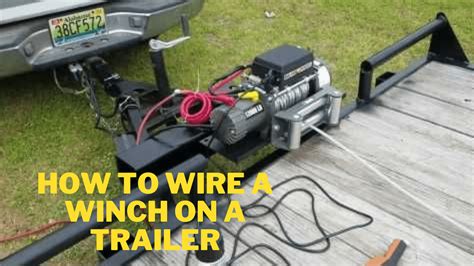Master Trailer Winch Wiring in Under an Hour: A Step-by-Step Guide
Wiring a trailer winch might seem daunting, but with the right instructions and a methodical approach, you can complete the job in under an hour. This guide focuses on Master winches, known for their reliability and straightforward wiring, but the principles apply to many winch brands. We'll cover everything from safety precautions to troubleshooting, ensuring you're ready to tackle this project confidently.
Safety First: Essential Precautions Before You Begin
Before even touching a wire, prioritize safety. These steps are crucial:
- Disconnect the Battery: This is the most important step. Disconnect both the positive (+) and negative (-) terminals of your vehicle's battery to prevent accidental shorts and electrical shocks.
- Wear Safety Glasses: Protecting your eyes from sparks and debris is vital.
- Use Insulated Tools: Avoid using metal tools that could accidentally short-circuit the wiring.
- Work in a Well-Lit Area: Good visibility reduces the chances of mistakes.
- Consult Your Winch Manual: Every winch model has its own specifications; always refer to the manufacturer's manual for detailed diagrams and instructions.
Understanding Your Master Winch Wiring Diagram
Master winches generally use a relatively simple wiring system. Your winch will come with a wiring diagram; familiarize yourself with it before starting. Typically, you'll find wires for:
- Power (Positive, +): Connects to your vehicle's battery positive terminal.
- Ground (Negative, -): Connects to your vehicle's battery negative terminal (or a suitable chassis ground).
- Motor Control (In/Out): These wires control the motor's direction (in for winding, out for unwinding). These are often connected to a switch.
- Remote Control (Optional): Some winches have an optional remote control connection.
Note: Wire colors may vary depending on the specific Master winch model. Always double-check your winch's manual.
Step-by-Step Wiring Guide: Master Trailer Winch Installation
-
Secure the Winch: Mount your Master winch securely to your trailer according to the manufacturer's instructions.
-
Prepare the Wiring: Organize your wires to avoid tangles. Use appropriately sized wire connectors (crimp connectors are recommended) to ensure a secure connection.
-
Connect the Power Wires: Connect the positive (+) wire from the winch to the positive (+) terminal of your vehicle's battery using a heavy-gauge wire (the size will be specified in the winch manual). Connect the negative (-) wire from the winch to the negative (-) terminal of your vehicle's battery. Make sure connections are clean and tight.
-
Connect the Control Wires: Connect the motor control wires (In/Out) to your winch switch. These connections usually involve a relay system for safety and to handle the higher amperage draw of the winch motor. The wiring diagram will clearly indicate which wire goes to which terminal on the switch.
-
Connect the Remote Control (If Applicable): If you're installing a remote control, connect it according to the instructions provided with your winch and remote. This often involves an additional relay or control box.
-
Test the Winch: Reconnect your vehicle's battery. Test the winch by engaging the switch. The winch should spool in or out smoothly. If not, double-check all connections.
Troubleshooting Common Wiring Problems
- Winch Doesn't Work: Check all connections, ensuring they're clean and tight. Make sure the battery terminals are properly secured and free from corrosion. Inspect the fuses (if applicable).
- Winch Runs in Reverse: You may have accidentally reversed the control wires. Double-check the wiring diagram and correct the connections.
- Overheating: Check the winch's wiring for loose connections or frayed wires which can cause excess resistance and overheating.
- Spark during operation: This signifies a loose or improperly wired connection. Carefully check every connection and tighten any loose terminals.
How Do I Wire a Master Winch with a Remote Control?
Wiring a Master winch with a remote control requires additional components, most often a wired or wireless control box. Your remote usually connects to this box, which then manages power and control signals to the winch. The specific steps will vary depending on the type of remote and the model of your winch; consult your winch's manual and the remote's instructions for detailed steps.
What Gauge Wire Should I Use for My Master Winch?
The appropriate gauge wire for your Master winch is specified in the manufacturer's documentation. Using a wire gauge too small can lead to overheating and failure. Always use the recommended gauge or larger.
Conclusion: Mastering Your Master Winch
With careful planning and adherence to the steps outlined above, wiring your Master trailer winch should be a straightforward process achievable in under an hour. Remember, safety is paramount, so take your time, double-check your work, and consult your winch manual if you have any doubts. Happy winching!

